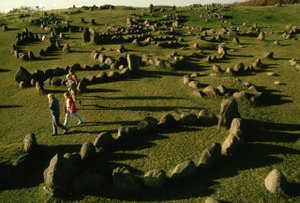While the words “Viking Funeral” may call to mind images of grandly burning pyres, warrior heroes laid to waste, set to sea to have their ship lit from afar by a burning arrow, much of this is the work of pop culture fiction. In fact, ancient Scandinavian Norse funeral burials were not altogether distinct from burial rituals throughout Europe or the world at the time, employing cremation and burial with personal effects. The Antonio Banderas flick, and Michael Crichton novel, The 13th Warrior, is one of many pop culture offerings to establish the fictional Norse funeral image, in which the standard was for the deceased to be set to see aboard his ship, then to be set afire by a skillfully fired flaming arrow. In fact, 10th Century sea-going vessels were far too valuable for so elaborate a send-off, and their dead were so numerous — while Viking captains were sometimes honored with burial inside their boat, there are no documented cases of the boat being put to sea and then set afire. Rather, the remains of fallen thrall, or ancient Nordic peoples, were often buried simply in little more than a shallow grave piled with stones and grave offerings, items of significance to the dead person’s life or family. For the more established members of a tribe, cremation in a funeral pyre was common practice, and their ashes could then be interred in an urn, and entombed in the deceased’s ship, which was then buried and marked with stones and shrines. The ship would also be loaded with grave offerings, and even the remains of animal or human sacrifices. These mounds are called tumuli, and they sometimes constituted entire acres of land, such as the Jelling mounds in Denmark. Royal Viking grave sites, carefully preserved over the centuries, are dotted throughout the sea-blasted countries of Northern Europe. But the most important element of the Viking funeral, for the wealthy and for the common man alike, was the open-air cremation, the funeral pyre, as it was believed that the winds that caught the burning fiber would carry the fallen thrall’s soul to heaven.
WELCOME TO OUR BLOG


Welcome to the SevenPonds.com blog – a community-driven extension of SevenPonds.com! I hope you find comfort and community in the resources and stories featured here. I’m always happy to hear from readers and can be reached at suzette@sevenponds.com.
FEATURED
-

 “In Case You Don’t Live Forever” by Ben Platt: Melodic ballad honors those who’ve come before us
“In Case You Don’t Live Forever” by Ben Platt: Melodic ballad honors those who’ve come before us -

 Our Monthly Tip: Make an “In Case of Death” File to Ease Loved One’s Grief: How preparing for your own death can be the ultimate act of love
Our Monthly Tip: Make an “In Case of Death” File to Ease Loved One’s Grief: How preparing for your own death can be the ultimate act of love -

 Passing of Beloved Comedian Births a New Comedy Festival: Kenny DeForest keeps us laughing long after he's gone
Passing of Beloved Comedian Births a New Comedy Festival: Kenny DeForest keeps us laughing long after he's gone
-
Categories

 How Ancient Nordic Viking Funeral Burials Reflect Common World Traditions
How Ancient Nordic Viking Funeral Burials Reflect Common World Traditions

















Giving them the respectful send off just as today’s culture practices. Cremation and burial services are the options we have today.
Report this comment
I love learning about how cultures, current or past, handle death. I think it says a lot about the way they think and see the world. Great post!
Report this comment
Thanks Huyen. Yeah, I’ve found it interesting how you can research all these different practices and cultures, and while there are huge differences, there are almost as many similarities and points in common, just with different strategies.
Report this comment